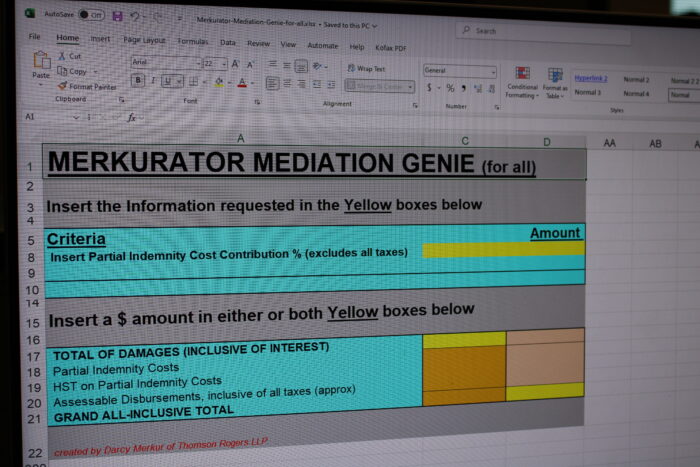Think Your Client is Not “Catastrophically Impaired”? – Think Again
Author(s): David A. Payne
April 1, 2005
The compensation that victims of motor vehicle accidents have available to them is fundamentally determined by whether or not the injuries suffered result in a “catastrophic impairment”.
For any person injured since 1996, their potential no-fault benefit limits for combined attendant care and medical/rehabilitation needs is either $172,000.00 or $2,000,000.00, depending on whether or not this person is “catastrophically impaired”.
For any person injured between November 1996 and October 2003, this same distinction determined whether this person could claim in court for attendant care and medical/rehabilitation needs (health care), against a person at fault for causing the injuries. Notwithstanding the key importance of a “catastrophic impairment” finding, to properly compensate individuals seriously injured in a motor vehicle accident, there was a lack of judicial guidance and great uncertainty on how to properly make this determination.
On November 17, 2004, Mr. Justice Spiegel, in a detailed and thoughtful judgment in the case of Desbiens v. Mordini, [2004] O.J. No. 4735, provided clear guidance on how the catastrophic determination is to be made. The decision changed many of the approaches and rules that insurers, doctors, lawyers and Designated Assessment Centres have been using when determining whether someone is, or is not, catastrophically impaired.
As a result of this case, many injured victims, who never attempted to be declared catastrophically impaired, or were determined by Catastrophic Designated Assessment Centres (CAT DACs) to not be catastrophically impaired, may find out that in fact they are.
The purpose of this article is to alert all persons seriously injured in car accidents to this change in the law, and to urge them to ensure they revisit this matter. As long as you have not settled your future no-fault entitlement, it is not too late.
The background:
The Law:
In order to be catastrophically impaired, the law states:
“5.(1) For the purposes of subsection 267.5(4) of the Act, “catastrophic impairment” means, … (f) subject to subsections (2) and (3), any impairment or combination of impairments that, in accordance with the American Medical Association’s Guides to the Evaluation of Permanent Impairment, 4th edition, 1993, results in 55 per cent or more impairment of the whole person; or (g) subject to subsections (2) and (3), any impairment that in accordance with the American Medical Association’s Guides to the Evaluation of Permanent Impairment, 4th edition, 1993, results in a class 4 impairment (marked impairment) or class 5 impairment (extreme impairment) due to mental or behavioral disorder. … (3) For the purposes of clauses (f) and (g) of the definition of “catastrophic impairment” in subsection (1), an impairment that is sustained by a person but is not listed in the American Medical Association’s Guides to the Evaluation of Permanent Impairment, 4th edition, 1993 shall be deemed to be the impairment that is listed in that document and that is more analogous to the impairment sustained by the person.
“impairment” means a loss or abnormality of a psychological, physiological or anatomical structure or function.”
The American Medical Association’s Guides to the Evaluation of Permanent Impairment, 4th edition
The Guides is a book which provides a doctor with a format for analyzing, assessing and recording functional impairments to all parts of the body. After assigning a percentage value to an individual’s particular impairments, a formula set out in a chart is used to combine them into a final “whole person impairment” (WPI). If this whole person impairment is 55% or above, the injured person is deemed to be catastrophically impaired.
In Desbiens, the court made clear what it thought of using the Guides as a determining criteria for the compensation available to individuals seriously injured in a motor vehicle accident,
“While the editors acknowledge the Guides may be used in the litigation process, they caution against using the impairment percentages derived, to make direct financial awards. As Lax, J. pointed out in Snushall v. Fulsang, the insurance legislation in Ontario appears to require precisely what the Guides themselves discourage. It has also been pointed out that the Guides are not designed to assess treatment or rehabilitation service requirements. Therefore, under Bill 59 we have the anomalous situation that the determination of entitlement to recovery of health care expenses in a tort action is governed by a set of guidelines that do not address the need for healthcare or the estimated costs thereof.” (see page 22)
Having expressed this view, the court then turned itself to the particular issues.
Can an injured person’s psychological impairments be given an impairment value and used towards achieving a 55% whole person impairment (catastrophically impaired)?
As strange as it may seem, every kind of impairment (injury) is given a percentage in the Guides, except mental or behavioral disorder injuries.
Instead, these injuries have their own separate criteria set out in Chapter 14 of the Guides. They are described as mild, moderate, marked and extreme impairments, arising from a mental and behavioral disorder. The level of impairment is assessed by reference to four separate domains, which are, daily functioning, work, social functioning, and concentration.
The court stated that if you have a marked or extreme impairment in any one of these domains, you are deemed to be catastrophically impaired.
A difficulty arises, however, if somebody injured in a motor vehicle accident has a very serious psychological or psychiatric injury/condition but not so serious as to pass the Chapter 14 “marked” or “extreme” threshold. What do you do with this impairment? Defense lawyers, adjusters and most Designated Assessment Centres, have historically stated or determined that you could not assign any percentage impairment from a psychological or psychiatric impairment in calculating the 55% whole person impairment threshold for a catastrophic impairment finding.
Anyone practicing in this area of law knows the great frustration of an injured person desperately needing more than the $100,000.00 non-catastrophic level of medical and rehabilitation no-fault benefits. Many injured people have, for example, a purely physical (whole person) impairment below 55% and the Designated Assessment Centre would not assign any percentage impairment, for the person’s clearly disabling psychological or psychiatric injury which, if it did, would result in a whole person impairment finding of 55% or above, and therefore a catastrophic impairment finding.
Justice Spiegel reviewed the law, in detail, and ruled:
“I find that it is in accordance with the Guides to assign percentages to Mr. Desbiens’ psychological impairments and to combine them with his physical impairments in determining whether he meets the definition of catastrophic impairment under clause (f).” (see page 50)
By analogizing the impairments from Chapter 4 of the Guides, the court assigned an additional 25% psychological impairment to the whole person impairment, and this put the injured Mr. Desbiens over the 55% minimum, so that he was deemed to be catastrophically impaired.
How is the whole person impairment calculated for a person who has pre-existing impairments?
Many individuals injured in car accidents have pre-existing impairments. In Mr. Desbiens’ case, they were extreme. Prior to the motor vehicle accident, he was already a paraplegic from a prior work-related accident. The court (having not assessed a 25% psychological impairment to the whole person impairment) determined Mr. Desbiens to have a 40% whole person impairment, thus well below the 55% threshold level for a catastrophic finding. The difficulty, as stated by the court, was:
“The Guides are premised on the assumption that one is dealing with a healthy person who sustains impairments as a result of an injurious event.” (see page 36)
It was agreed by all parties:
“The Guides permit and in fact anticipate, that the assessor will exercise discretion where the impairment percentage arrived at does not accurately reflect the real functional impairment sustained by the injured person.” (see page 36)
There was a disagreement by the experts for the plaintiff and the defendant on the proper way to exercise this discretion. The court agreed with and adopted the approach and opinion of Mr. Desbiens’ expert physician, and stated:
“A WPI of 40% when superimposed upon Mr. Desbiens’ paraplegia had grave consequences for his ability to function that are not adequately reflected by a WPI of 40%. Viewed in this manner, she was of the opinion that Mr. Desbiens had sustained a catastrophic impairment in the car accident.” (see page 36)
Therefore, on a physical basis alone, Mr. Desbiens was deemed to be catastrophic.
Conclusion
Any injured party who had pre-existing injuries or has a psychological or psychiatric component to their injury, and hasn’t applied for a catastrophic impairment designation or has had a Designated Assessment Centre turn them down, should have this matter revisited.
As Justice Spieigel stated:
“The drafters clearly intended the definition of “catastrophic impairment” to be inclusive rather than restrictive.” (see page 48)
Share this




